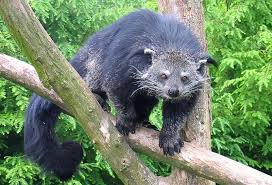Binturong:

A rare Binturong was recently captured on a camera trap set up by the Wildlife Trust of India’s Garo Green Spine project team in the Narang Wari Village Reserve Forest (VRF), located in the buffer zone of Balpakram National Park.
- It is a catlike omnivore of the civet family.
- It is the largest civet in India, colloquially known as the bearcat.
- Scientific Name: Arctictis binturong
- It is found in dense forests of Southeast Asia.
- Its range extends from Nepal, India, and Bhutan southward to the Indonesian islands of Sumatra and Java and eastward to Borneo.
- The head and body measure about 60–95 cm and the tail an additional 55–90 cm; weight ranges from about 9 to 14 kg (20 to 31 pounds).
- It has long, shaggy hair, tufted ears, and a long, bushy, prehensile tail.
- The colour generally is black with a sprinkling of whitish hairs.
- It is principally nocturnal and crepuscular (that is, active during twilight).
- It is found most often among the trees, using its prehensile tail as an aid in climbing.
- It has scent glands, which are located just under its tail. These glands are used to mark trees and foliage to outline an individual’s territory.
- Conservation Status:
- IUCN: Vulnerable
- Wildlife Protection Act of 1972: Schedule I
- CITES: Appendix III




